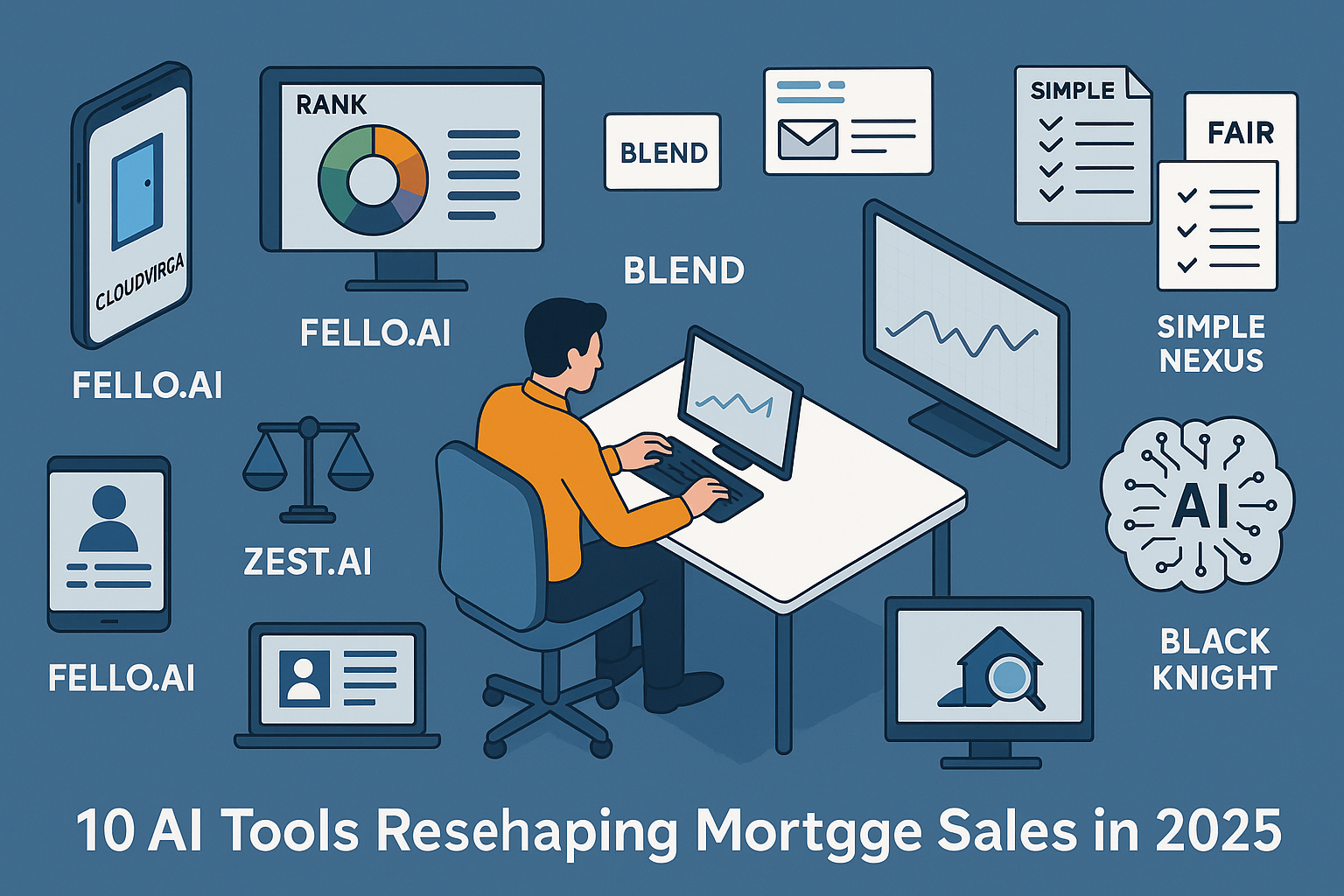What's in this article?
The mortgage industry is experiencing unprecedented challenges. With loan officer numbers down 46% since 2022 and average production at just 21 loans per year per officer, efficiency has never been more critical. While digital satisfaction scores dropped 8 points year-over-year in 2024, the right productivity tools can turn the tide, helping loan officers maximize their limited time and resources.
The average loan officer now closes $6.6 million in production annually, but the gap between top performers and the rest continues to widen. With a 25% turnover rate plaguing the industry, mortgage professionals need tools that deliver immediate impact, not just promise.
1. AI-Powered Lead Scoring and Assignment Systems
Traditional lead distribution methods waste valuable opportunities. Modern AI systems analyze historical conversion data, borrower profiles, and loan officer performance to match leads with the highest probability of success.
Key Features:
- Real-time lead quality assessment using predictive algorithms
- Dynamic assignment based on loan officer expertise and current workload
- Integration with existing CRM platforms for seamless workflow management
Impact on Performance:
When local brand representatives engage early in the process, borrower satisfaction increases by 40 points on a 1,000-point scale, directly correlating with higher conversion rates. Tools that facilitate this early engagement through intelligent lead routing maximize these satisfaction gains.
2. Automated Document Processing Solutions
The mortgage process involves extensive paperwork that traditionally requires hours of manual review. Modern document processing tools leverage optical character recognition and machine learning to extract, verify, and organize critical information automatically.
Productivity Benefits:
- Reduces document review time by up to 70%
- Minimizes errors in data extraction and entry
- Enables faster pre-qualification decisions
- Maintains compliance tracking automatically
With the industry moving from an average loss of $1,056 per loan in 2023 to a profit of $701 per loan in Q3 2024, efficiency tools like automated document processing have played a crucial role in this turnaround.
3. Intelligent CRM Systems with Predictive Analytics
Standard CRMs store data, but intelligent systems turn that data into actionable insights. These platforms analyze client communication patterns, financial profiles, and market conditions to suggest optimal outreach timing and messaging.
| Feature | Traditional CRM | Intelligent CRM |
| Lead Tracking | Manual entry | Automated capture |
| Follow-up Scheduling | Calendar-based | Behavior-triggered |
| Client Insights | Historical data | Predictive analysis |
| Conversion Optimization | Basic reporting | AI-driven recommendations |
4. Multi-Channel Communication Platforms
Today’s borrowers expect communication across multiple channels. Integrated platforms that manage email, text, phone calls, and video conferences from a single interface eliminate the productivity drain of switching between tools.
Communication Efficiency Gains:
- Unified inbox for all client interactions
- Automated response templates for common queries
- Real-time notification management
- Integration with loan origination systems
5. Market Intelligence and Pricing Tools
Loan officers need real-time market data to provide competitive rates and make informed recommendations. Advanced pricing tools integrate with multiple lending sources and provide instant rate comparisons and scenario modeling.
Strategic Advantages:
- Real-time rate shopping across multiple investors
- Automated pricing updates based on market conditions
- Scenario comparison tools for different loan products
- Compliance-checked pricing recommendations
The ROI Reality Check
The mortgage industry’s recovery from negative profitability to positive returns demonstrates the impact of productivity improvements. Companies that invested in efficiency tools during the downturn positioned themselves for stronger margins when market conditions improved.
With the current profit margin of $701 per loan, even modest productivity gains compound significantly. A tool that saves two hours per loan at a loaded hourly rate of $75 pays for itself quickly, especially when multiplied across dozens of monthly transactions.
Implementation Strategy for Maximum Impact
Successful tool adoption requires a systematic approach. Start with the highest-impact, lowest-complexity solutions first. Document processing automation typically delivers immediate ROI, while AI-powered lead scoring systems require more data integration but offer greater long-term benefits.
Phased Rollout Approach:
- Implement document automation for immediate time savings
- Integrate communication platforms to reduce context switching
- Deploy intelligent CRM features for better client insights
- Add market intelligence tools for competitive advantage
- Implement AI lead scoring as data quality improves
Ready to Transform Your Productivity?
The mortgage industry’s dramatic shift from losses to profitability in 2024 proves that operational efficiency directly impacts bottom-line results. With loan officer numbers at historic lows and competition intensifying, productivity tools aren’t just nice-to-have features anymore.
Frequently Asked Questions
What’s the average ROI timeline for mortgage productivity tools?
Most document automation and communication tools show positive ROI within 30–60 days. AI-powered systems typically require 90–120 days to demonstrate full impact as they learn from your data patterns.
How do productivity tools integrate with existing loan origination systems?
Modern productivity tools use APIs to integrate seamlessly with major LOS platforms like Encompass, Calyx Point, and BytePro. Integration typically requires minimal IT involvement and can be completed within days.
What’s the learning curve for adopting new productivity tools?
Basic automation tools require minimal training, often just 2–3 hours. More sophisticated AI systems benefit from dedicated onboarding sessions but most loan officers become proficient within their first week of use.
How do these tools help with compliance requirements?
Advanced productivity tools include built-in compliance checking, automated audit trails, and regulatory reporting features. They actually reduce compliance risks by standardizing processes and maintaining detailed documentation.
Can smaller mortgage brokerages benefit from these tools?
Yes, many productivity tools offer scalable pricing models that make them accessible to individual loan officers and small brokerages. The efficiency gains are often more pronounced for smaller operations with limited administrative support.



